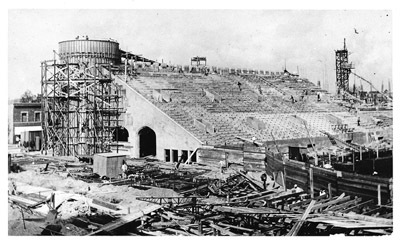 From
Our Pages
From
Our Pages
1912 Construction
began on a new grandstand and cement fence for Marshall Field, later renamed Stagg
Field. The $200,000 project increased seating capacity to 18,000 (25,000 with
portable bleachers). Turrets at either end contained fan restrooms and team locker
rooms, and underneath the grandstand were handball and racquetball courts. The
stadium in its final form-with 50,000 seats-was most famous not for football,
but for the first-ever self-sustaining nuclear chain reaction, which occurred
under the west stands on December 2, 1942. Stagg Field was torn down in 1957 to
make room for Regenstein Library.
|
Built
two years before Wrigley Field, Marshall Field seated 25,000 for Maroon football
games.
University of Chicago Library
Special Collections Research Center |
1952
Life on Mars, wrote astronomy professor Gerard P. Kuiper in an excerpt from The
Atmospheres of the Earth and the Planets (University of Chicago Press), is
a distinct possibility. His spectroscope analysis of the Martian surface and atmosphere
showed that conditions could support crustose lichens. "If life truly exists
on the only two planets of the solar system that are at all suitable to sustain
it," postulated Kuiper, "it is tempting to conclude that, after enough
time has elapsed, it will develop spontaneously wherever conditions permit. Since
planetary systems are presumed to be very numerous, life would then be no exception
in the universe."
1977
The Autumn issue featured "The Monkey's Tale," an excerpt from religion
professor Anthony C. Yu's four-volume, annotated translation of The Journey
to the West (University of Chicago Press). The 16th-century Chinese epic narrative
recounts the monk Hsüan-tsang's pilgrimage to acquire Buddhist scriptures
from India. This episode was so popular, commented Yu, PhD'69, who today is the
Carl Darling Buck distinguished service professor in the humanities and professor
of religion and literature in the Divinity School, that "even the late Mao
Tse-tung wrote a poem on this particular segment of The Journey to the West."
1992
Ever imagine the University of Chicago campus with an 11-story combined library
and administration building in the center of the main quads or with an art gallery
anchoring the Midway? In a Centennial exhibit the Smart Museum took "a look
at what almost was" with The Gray City Unbuilt: Architectural Proposals
for the University of Chicago, which included 20 drawings of rejected designs.
"One of the great difficulties about an academic building is that it is practically
imperishable," wrote Magazine editor William Morgenstern, PhB'20,
JD'22, commenting about the Adminstration Building in 1946, "and so, an academic
plant is even harder to improve than a curriculum."
- Evan Haglund


![]() Contact
Contact
![]() About
the Magazine
About
the Magazine ![]() Alumni
Gateway
Alumni
Gateway ![]() Alumni
Directory
Alumni
Directory ![]() UChicago
UChicago![]() ©2002 The University
of Chicago® Magazine
©2002 The University
of Chicago® Magazine ![]() 5801 South Ellis Ave., Chicago, IL 60637
5801 South Ellis Ave., Chicago, IL 60637![]() fax: 773/702-0495
fax: 773/702-0495 ![]() uchicago-magazine@uchicago.edu
uchicago-magazine@uchicago.edu
